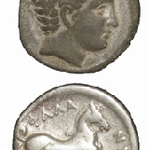Thessalian Silver Drachm of Phalanna, 400 BCE - 340 BCE
Silver
C.7679
Further images
Obverse: Bust of a Young Man Facing Righ Reverse: Bridled Horse Walking to the Right, Inscription Above Translated as 'Phalann' The ancient city of Phalanna is situated on the Peneios...
Obverse: Bust of a Young Man Facing Righ
Reverse: Bridled Horse Walking to the Right, Inscription Above Translated as "Phalann"
The ancient city of Phalanna is situated on the Peneios River, near to Larissa in Thessaly. Phalanna was the capital of the Perraebi, an ancient Greek people who for most of their history were dominated by Thessaly. Most small city states marked their coinage with their name in order to keep track of the movements of people and currency throughout the mainland. Condition is fine, with evidence of use that does not conceal the fine quality of the casting.
How many hands have touched a coin in your pocket or your purse? What eras and lands have the coin traversed on its journey into our possession? As we reach into our pockets to pull out some change, we rarely hesitate to think of who touched the coin before us, or where the coin will venture to after us. More than money, coins are a symbol of the state that struck them, of a specific time and place, whether contemporary currencies or artifacts of long forgotten empires. This stunning hand-struck coin reveals an expertise of craftsmanship and intricate sculptural detail that is often lacking in contemporary machine-made currencies. This coin is a memorial an ancient city passed from the hands of civilization to civilization, from generation to generation.
Reverse: Bridled Horse Walking to the Right, Inscription Above Translated as "Phalann"
The ancient city of Phalanna is situated on the Peneios River, near to Larissa in Thessaly. Phalanna was the capital of the Perraebi, an ancient Greek people who for most of their history were dominated by Thessaly. Most small city states marked their coinage with their name in order to keep track of the movements of people and currency throughout the mainland. Condition is fine, with evidence of use that does not conceal the fine quality of the casting.
How many hands have touched a coin in your pocket or your purse? What eras and lands have the coin traversed on its journey into our possession? As we reach into our pockets to pull out some change, we rarely hesitate to think of who touched the coin before us, or where the coin will venture to after us. More than money, coins are a symbol of the state that struck them, of a specific time and place, whether contemporary currencies or artifacts of long forgotten empires. This stunning hand-struck coin reveals an expertise of craftsmanship and intricate sculptural detail that is often lacking in contemporary machine-made currencies. This coin is a memorial an ancient city passed from the hands of civilization to civilization, from generation to generation.





